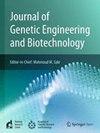一种新的抗人乳头瘤病毒和白色念珠菌多表位疫苗的评价
IF 2.8
Q3 Biochemistry, Genetics and Molecular Biology
Journal of Genetic Engineering and Biotechnology
Pub Date : 2025-05-02
DOI:10.1016/j.jgeb.2025.100489
引用次数: 0
摘要
目的设计并评价一种针对人树突状细胞(hDC)的人乳头瘤病毒(HPV)和白色念珠菌(C. albicans)的多表位肽疫苗。方法从NCBI中提取FASTA格式的靶蛋白,确定白色念珠菌和HPV的抗原表位。然后,使用ABCpred、Vaxijen、AllerTOP、ToxinPred和分子对接分析所有表位。然后,首先采用固相法合成选定的多肽,与阳离子脂质混合,并在280 nm处用DLS、Zetasizer和nanodrop进行表征。下一步,从外周血中获得hDCs,并通过流式细胞术进行确认。然后,他们暴露于1毫克/毫升的候选疫苗。接下来,通过白细胞介素-12 (IL-12)和干扰素- α (IFN- α)的表达和浓度来检测hDC的激活。此外,我们还通过混合淋巴细胞反应(MLR)诱导同种异体T细胞增殖的能力来评估hdl和抗原负载hdl的功能。最后,用ELISA法研究了叙利亚雄性小鼠对候选疫苗的抗体滴定。结果选择KDIDLDLQEL、GPVLALNVAL和KDIDLDLQELKKKGPVLALNVAL肽段分别为E7、HYR1和合并的E7-HYR1肽段。我们发现超过85%的分离出的hDCs对HLA-DR、CD86和CD209呈阳性,而不到5%的人对CD14呈阳性。在用候选疫苗治疗hDCs后,我们发现肽E7、HYR1和合并的E7-HYR1可以刺激hDCs表达IL-12和IFN- α,当选择的肽整合到纳米脂质体中时,它们明显更有能力刺激hDC (P <;0.05)。此外,我们还发现,接种了疫苗的hDCs的刺激指数高于未接种的hDCs。暴露于纳米脂质体的小鼠的抗体滴度明显高于暴露于特定肽疫苗的小鼠。P & P;与其他组比较为0.05。结论设计了一种针对HPV和白色念珠菌的多表位肽疫苗,并在hDC上进行了评价。这种疫苗的真正功效和副作用必须在未来的研究中进行分析。本文章由计算机程序翻译,如有差异,请以英文原文为准。
The evaluation of a novel multi-epitope vaccine against human papillomavirus and Candida albicans
Purpose
The purpose of this study was to design and evaluate a multiepitope peptide vaccine against Human papillomavirus (HPV) and Candida albicans (C. albicans) on human dendritic cells (hDC).
Methods
To determine the antigenic epitopes for C. albicans and HPV, the FASTA format of protein targets was extracted from NCBI. Then, all epitopes were analyzed using ABCpred, Vaxijen, AllerTOP, ToxinPred, and molecular docking. Then, selected peptides were first synthesized using the solid phase method, mixed with cationic lipids, and characterized by DLS, Zetasizer, and nanodrop at 280 nm. In the next step, hDCs were obtained from peripheral blood and confirmed by flow cytometry. Then, they were exposed to vaccine candidates at 1 mg/mL. Next, the activation of hDC was checked by the expression and concentration of interleukin-12 (IL-12) and interferon-ɣ (IFN-ɣ). Also, the functionality of hDCs and antigen-loaded hDCs was evaluated by their ability to induce the proliferation of allogeneic T cells by mixed lymphocyte reaction (MLR). Finally, antibody titration against vaccine candidates was investigated on Syrian male mice using the ELISA method.
Results
Here, KDIDLDLQEL, GPVLALNVAL, and KDIDLDLQELKKKGPVLALNVAL peptides were selected as E7, HYR1, and merged E7-HYR1 peptides, respectively. We found that more than 85 % of the isolated hDCs were positive for HLA-DR, CD86, and CD209 and less than 5 % were positive for CD14. After treatment of hDCs with vaccine candidates, we found that peptides E7, HYR1, and merged E7-HYR1 could stimulate hDCs to express IL-12 and IFN-ɣ and when the selected peptides integrated into nanoliposomes, they were significantly more capable to stimulate hDC (P < 0.05). Also, we found that the stimulation index of vaccine-loaded hDCs was higher than unloaded hDCs. The antibody titer in mice exposed to nanoliposomes was significantly higher than in mice exposed to specific peptide vaccines. a P < 0.05 compared with other groups.
Conclusion
Here, a multiepitope peptide vaccine against HPV and C. albicans was designed and evaluated on hDC. Real efficacy and side effects of this vaccine must be analyzed in future studies.
求助全文
通过发布文献求助,成功后即可免费获取论文全文。
去求助
来源期刊

Journal of Genetic Engineering and Biotechnology
Biochemistry, Genetics and Molecular Biology-Biotechnology
CiteScore
5.70
自引率
5.70%
发文量
159
审稿时长
16 weeks
期刊介绍:
Journal of genetic engineering and biotechnology is devoted to rapid publication of full-length research papers that leads to significant contribution in advancing knowledge in genetic engineering and biotechnology and provide novel perspectives in this research area. JGEB includes all major themes related to genetic engineering and recombinant DNA. The area of interest of JGEB includes but not restricted to: •Plant genetics •Animal genetics •Bacterial enzymes •Agricultural Biotechnology, •Biochemistry, •Biophysics, •Bioinformatics, •Environmental Biotechnology, •Industrial Biotechnology, •Microbial biotechnology, •Medical Biotechnology, •Bioenergy, Biosafety, •Biosecurity, •Bioethics, •GMOS, •Genomic, •Proteomic JGEB accepts
 求助内容:
求助内容: 应助结果提醒方式:
应助结果提醒方式:


